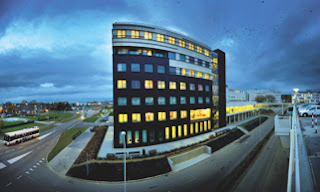For many patients a hospital clinic can be a cold forbidding place. But this doesn't always have to be the case.
In the June Cover Story of EuroTimes, our Contributing Editor Howard Larkin , who is based in Chicago, interviewed a number of ophthalmologists and architects in the US and Europe.
They have decided that as the patient is the customer, and not the doctor, their clinics should be designed to make their patients comfortable and to alleviate their anxieties.
The spectacular image above is the exterior of the the seven-story Eye Tower of the University Eye Clinic Maastricht in The Netherlands. The Eye Tower has drawn rave reviews from patients, doctors, researchers and students alike, says Rudy MMA Nuijts MD, PhD, who heads the cornea service and refractive surgery at the clinic, and Carroll Webers, MD, PhD, chairman of the department. Its sleek façade and welcoming interior also have been celebrated in high-profile architecture and art digests.
Most important, the University Eye Clinic Maastricht is enabling a steady increase in patient and procedure volume, they said. With the ageing of the population the department expects more demand for everything from diabetes and age-related retinal services to glaucoma, cornea, cataract and refractive procedures, not to mention routine primary eye care.
Clinic volume already exceeds the capacity of the department’s previous cramped quarters, and is on track to achieve a major increase over the next few years, they said. Most patients are still from The Netherlands, but they expect cross-border business may pick up as demand grows.
*Read the full story at http://www.eurotimes.org/cover-news.asp?id=3589 and see the image gallery at http://www.eurotimes.org/gallery.asp?id=72157635068524134
Dr Nuijts and Dr Webers will be talking about their clinic at the ESCRS Practice Development Programme on Sunday 6 October at the XXXI Congress of the ESCRS in Amsterdam, Holland.
See http://www.escrs.org/amsterdam2013/programme/practice-development.asp





